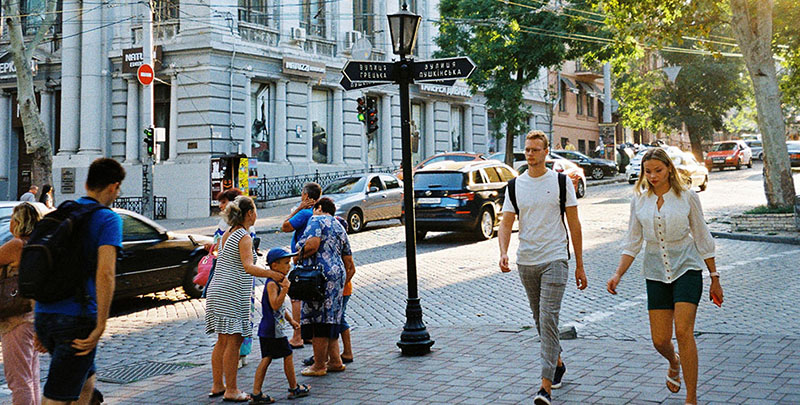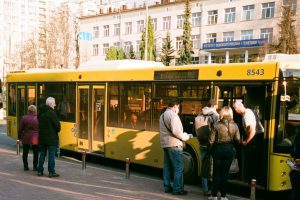28.1 Verbs of Motion (іти – їхати)

In this module, you will begin to learn how verbs of motion work in Ukrainian. You will become familiar with when and how to use two key verbs of motion, іти́ and ї́хати.
Завда́ння 1
Read the conversation between the two friends pictured in the photo, paying attention to the bolded words. Then answer the questions that follow.
– Приві́т, Софі́є! Куди́ ти іде́ш? На заня́ття?
– Приві́т, Окса́но! Так, іду́ на ле́кцію! А ти куди́?
– Я шука́ю гурто́житок № 5. Там живе́ моя́ нова́ знайо́ма. Ти не зна́єш, де він?
– А чому́ ти ї́деш в гурто́житок велосипе́дом? Він ду́же бли́зько – он там, де іду́ть ті три студе́нти.
– О, дя́кую! Я ї́ду, бо не зна́ла, чи це дале́ко. Ну, і по́тім я ма́ю ї́хати на робо́ту, а це не так бли́зько.
– Ага́, розумі́ю… Ой, ви́бач, Окса́но, я му́шу іти́, бо запі́знююся на ле́кцію!
Важли́во!
Unlike the versatile English verb “to go,” Ukrainian verbs of motion specify how the “going” is done. If one is going on foot, іти́ (or its variant йти) is used. If one is going by any kind of ground “transportation” (car, bus, train, bicycle, skis), the verb ї́хати is used.
Both verbs are imperfective and can denote action in progress in the past, present, or future tenses. In the present tense, both verbs take hard-vowel endings of the first conjugation, like the verbs писа́ти and жи́ти:
| прийти́ | |
|---|---|
| я | прийду́ |
| ти | при́йдеш |
| він/вона/воно | при́йде |
| ми | при́йдемо |
| ви | при́йдете |
| вони | при́йдуть |
Despite looking somewhat different in their infinitive forms, these verbs look and sound VERY similar in their present-tense forms. The difference in stress is what really helps one to tell them apart in spoken Ukrainian: іти́ forms have stress on the last syllable and ї́хати forms have stress on the first syllable.
Finally, in questions about the destination of one’s “going,” Ukrainian uses a particular question word – куди́? (where to?)
Куди́ ти іде́ш?
(Literally: To where are you walking?)
Куди́ ви ї́дете?
(Literally: To where are you going [by vehicle]?)
Завда́ння 2
For each sentence you hear, indicate whether the person or people are going on foot (пі́шки) or by vehicle (тра́нспортом).
Transcript – Завдання 2
- Я іду в парк.
- Куди ви їдете?
- Ми ідемо на річку.
- Батьки їдуть до Києва на вихідні.
- Куди іде Володя?
- Я їду на конференцію.
- Сестра їде в центр.
- Куди ти ідеш?
Важли́во!
In sentences with the verbs of motion, the destination to which one is going will appear in the accusative case after prepositions в (у) and на. This is in contrast to the sentences about one’s location, in which location will always be in the locative case. Compare:
Ми ідемо́ в парк на прогу́лянку.
(We are going to a park for a walk.)
Ми в па́рку на прогу́лянці.
(We are at the park on a walk.)
See module 8.2 for more on this distinction.
When specifying the means of transportation by which one is going, this transportation will appear in the instrumental case:
Батьки́ ї́дуть на мо́ре маши́ною.
(The parents are going to the sea by car.)
For more on this use of the instrumental case, see module 10.1.
To specify going on foot, one can use the adverb пі́шки:
Сього́дні я іду́ в університе́т пі́шки.
(Today I’m going to the university on foot.)
Завда́ння 3
The sentences below describe Ivan’s somewhat complicated commute to work. First, select the most appropriate verb of motion to use in each sentence. Then number the sentences in the order that most likely reflects the sequence of actions in Ivan’s commute. Hint: The image below shows the first means of transportation that Ivan uses.
Завда́ння 4
Complete the caption for each image by selecting the correct verb form and destination.
Ціка́во!
In discussions of going to events or some cultural places (such as теа́тр), when it is not important to indicate how exactly one is getting there, the verb іти́ is commonly used (even if in reality one would be going by vehicle there):
Миро́н іде́ на конце́рт.
(Myron is going to a concert.)
However, if the event or the destination is in a different town or a different part of the country (and thus, clearly not within walking distance), the verb їха́ти (or леті́ти = to fly) must be used:
Хло́пці ї́дуть у Філаде́льфію на футбо́льний матч.
(The guys are going to Philadelphia for a soccer game.)
Завда́ння 5
Complete the sentences below with the most appropriate verbs of motion and destinations from the bank.
Ціка́во!
Just like in English, the present-tense forms of the “going” verbs can refer to future events that have been planned and will definitely happen:
За́втра я іду́ на вече́рю до батькі́в.
(Tomorrow I’m going to my parents’ for dinner.)
В субо́ту ми ї́демо в Ха́рків.
(On Saturday we are going to Kharkiv.)
Завда́ння 6
Complete each question about future plans by selecting the most appropriate ending.
Transcript – Завдання 6
- Ти іде́ш…
- Ви ї́дете…
- Ти ї́деш…
- Ти іде́ш…
- Ви ї́дете…
- Ви іде́те…
Завда́ння 7
Read the conversation between two friends and mark all the forms of the verbs іти́ and ї́хати. Then answer the questions that follow.
Важли́во!
The verb іти́ has irregular past-tense forms that have to be memorized:
він ішо́в
вона́ ішла́
воно́ ішло́
вони́ ішли́
By contrast, the past-tense forms of ї́хати are regular: ї́хав, ї́хала, ї́хало, ї́хали. In the past tense, both of these verbs refer to “going” that was in progress at some point in the past.
Both іти́ and ї́хати have regular future-tense forms, either with бу́ти or the synthetic ones:
За́втра в цей час я бу́ду ї́хати (=ї́хатиму) по́тягом в Оде́су.
(At this time tomorrow I will be going by train to Odesa.)
Завда́ння 8
Complete the sentences with the appropriate forms of motion verbs from the bank. Then answer the question that follows.
Мо́вний пазл
Look through the activities you have just completed and choose the correct statements to summarize what you have learned.
А тепе́р тест!
Complete the dialogue below by providing the appropriate forms of іти́ and ї́хати. Pay close attention to the context to figure out which verb to use and in what tense, person, and number to put it.







